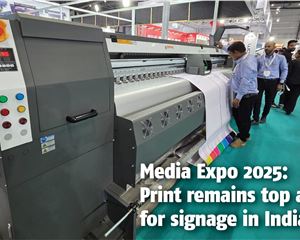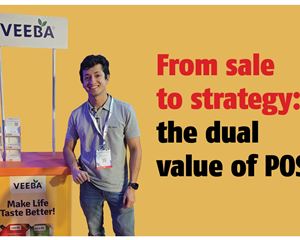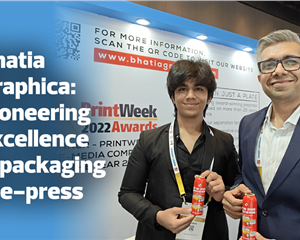How productive is archiving and reusing offset plates? - The Noel D'Cunha Sunday Column
Many offset printers reuse digital plates, post-
baked, because of increased print runs and other
benefits, but a lot depends on the print job it’s
intended for, and what are the production advantages
of using such plates.
Abhiram Sathe, head – technical
support for plates in India cluster for Kodak
undertook a survey to find out the real and perceived
advantages of reusing plates.
In this Sunday Column, Sathe shares the results
09 Aug 2020 | By Noel D'Cunha
The Indian offset print industry can be classified into four segments – commercial, offset packaging, publishing and newspaper. Over the years, a change that the Indian print industry has seen is, adopting the latest technologies to meet the ever-increasing demand of print buyers. "Apart from adopting the latest technologies, they also tend to be innovative and think of implementing out of the box ideas that help them increase their productivity in a cost-effective way," says Abhiram Sathe, head – technical support for plates in India cluster for Kodak.
However, there is one trend that has been observed when it comes to plates. Many printers wish to preserve and archive plates for reuse, even though no plate manufacturer claims the ability to re-print as a product feature. "Different print segments have different approaches and thought processes about reusing an offset printing plate," says Sathe, who has been mentoring customers and fellow colleagues over the years.
Sathe has been driving a project on analysing the cost implications of a process used by printers – the process of storing plates and reusing them for a repeat job, often described as a 'reprint job'.
Who does what, and why?
According to Sathe, there are commercial printers, which feel the need to keep the plates after the job is printed just in case copies fall short due to some error during post-press operations. Or they feel that clients might come back later demanding more copies; then they can use the same plates and optimise profits.
The offset packaging printers are already aware of the repeat of jobs. Mostly, they receive a supply schedule from their client and they control inventory by printing in small lots thus preferring to re-print from the same set of plates.
The publishing-printers also follow a similar process of printing small lots by carefully managing the demand-supply pattern of their clients.
The pros and cons
"One common attribute the offset packaging and publishing printers have is post-baking the plates to get multiple reuses and other benefits," says Sathe.
While there are some upsides to reusing post-baked plates, Sathe claims that there are considerable downsides. "In preserving the plates for reuse they often disregard the plate/s failure in terms of plate scum, image wear off, ink catch-up, uneven print density etc. These issues are known only after plates are mounted on press and printing of job starts. Seldom is the press operator aware of abnormalities by barely looking at the archived plate."
Sathe adds, "For a plate that is baked, even if 15Kw energy consumption is ignored (which is, in fact, huge), the addition of a process itself brings in a variable. There is always a chance of over/under baking based on the age of the baking oven, uneven application of baking gum before baking etc. which may cause a delay in makeready. There is wastage of sheets too."
In short, the re-print process is desired by printers, but plate manufacturers cannot consider this during product design due to technical reasons.
Hence it is worth finding out the practical impact of this methodology.
The survey
Sathe did a survey, the objective of which was to understand the commercial and productivity implications of archiving the plates after printing. The scope of this exercise was limited to understanding the cost implications (unproductive machine hours) of reusing of plates.
The survey involved 24 printers from different parts of India and having print operations catering to different print segments.
The methodology used to collect the data was –
- Select printers who preserve plates for re-printing
a. Users who preserve all plates by default after being printed
b. Users who selectively archive certain plates (for a certain job) - Get information on the rate of success when they use archived plates for reprinting
- Try and include diversity by type - commercial, packaging etc.; Size - by sales or turnover
Some of the survey questionnaires and results were as follows:
- What is the rejection rate of a plate when attempted re-print? Respondents claimed the rejection as high as 60% and the lowest being 30%. The average worked out to 38%. That means if 100 plates are taken to reuse, 38 would fail.
- What is the time lost to replace a new plate (making a new plate/s and loading them to the press)? The answer range was 20 min to 7 min. Average time recorded from responses is 9.7 min
- Number of working hours in a day (shift)? Average is 13 hrs.

Key findings
According to Sathe, the average downtime for making a new plate, unloading and loading is 9.7 minutes. The success rate while using an archived plate was 62% while 38% got rejected during re-print.
Extract and averaged out information indicated the following estimation around the impact of adopting the process of preserving the plate and re-printing. The data mentioned in the table is derived from the questionnaire asked during the survey.
| Particulars | Reported numbers | Remarks |
| Plates stored and used per month under re-print | 1000 | |
| Average failure rate when plate used to re-print | 38 % | |
| Actual plates failed per month | 380 | |
| Average time taken to remake and change the plate (avg. time 9.7min.)* | 0.12 | Hrs) * 25% discount if it could be more than one plate changed at a time |
| Production Time lost in hours per month- remake a plate and load | 46.2 | (Hrs) |
| 5000 sheets per hour is nominal production. Number of impressions lost per month | 231,000 |
Following additional costs are not considered during this study:
- Manpower and material for cleaning and preserving the plate
2. Space and facility for archiving, tagging and record maintenance
3. Delayed realisation of scrap value
4. Makeready sheets
Barring the above costs for consideration, thinking from a technical side, the dots reproduced on a plate are ruptured when plates are mounted on the press for printing. Sathe says, “No matter how well one stores the plate, to reproduce the quality exactly like the one printed with a fresh set of plates cannot be achieved and there is some compromise.”
This is of critical importance in the offset packaging segment as the print tolerance levels are very stringent.
In fact, for any type of printing compromise in the quality - is it what the clients really want?, asks Sathe. "Citing all the above details, one can think for themselves whether there are ‘real’ advantages of reusing the plates or only the ‘perceived’ advantages while reusing. As is often the case, the hidden costs of doing an activity are seldom considered and thus the true costs incurred are not highlighted."
Sathe concludes by saying, some food for thought - are printers being 'Penny Wise Pound Foolish' while reusing the plates?
Abhiram Sathe is a printing graduate of class of 1991 from PVG’s College of Engineering & Technology, Pune. He has rich experience of 25+ years working in the print industry. He is working at Kodak since 2008. Before joining Kodak, Sathe has worked with local as well as multi-national companies. At Kodak he has been successfully heading technical support for plates along with mentoring his colleagues. He is an expert in process-free technology and has guided many printers adopt it at their units. Within Kodak, he is a part of Kodak’s technical application group, a WW group of technical experts at Kodak.













 See All
See All